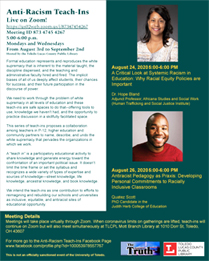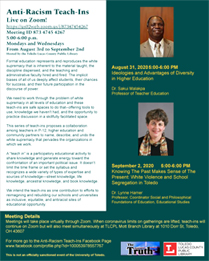|
Critical
Self-Reflection: Tools for Unpacking Seen, Unseen, and
Unforeseen Racial Biases
By Aaron Baker
The University of Toledo
The purpose of this teach-in was to introduce concepts,
theory, and practice related to critical self-reflection as
a foundation for anti-racist teaching. This required
defining antiracist teaching, along with the characteristics
of anti-racist teachers, and engaging participants in the
process of critical self-reflection with three approaches:
reflecting on self, reflecting on self in relation to
students, and shifting from self to system.
For the teach-in, we relied on educator, Beverly Tatum's,
definition of anti-racist teaching. She tells us that it is
the work of becoming an ally, an advocate for students of
color, and an anti-racist role model for all students. For
teachers of color, this means understanding that there are
social class differences among people of color,
acknowledging that all racial groups are struggling in some
way under White supremacy and realizing that people of color
are not always united in solidarity. For White teachers,
this means taking responsibility for their power and
privilege, acknowledging the feelings they may have toward
increased racial diversity in schools, and cultivating a
desire for personal understanding and growth. For all
teachers, this means an ongoing process of critical
self-reflection.
Critical self-reflection, which is sometimes attributed to
philosopher John Dewey, is a process of self-analysis. It
requires asking yourself challenging questions, observing
your behavior, and connecting facts to your experiences to
help you identify unwanted patterns and beliefs. In the
context of our teach-in, it is intended to help teachers
regularly identify their racial and cultural biases,
understand how those biases influence their teaching and
make changes so they can better serve all their students,
and the community beyond their school.
In recognition that critical self-reflection is necessary,
arduous work this teach-in provided participants tools,
based on the work of Professor Richard Milner, to help them
engage in this deeply personal process. He calls on
teachers to consider questions like “In what ways do my
racial and cultural backgrounds influence how I experience
the world, what I emphasize in my teaching, and how I
evaluate and interpret others and their experiences? How do
I know?” and “What systemic and organizational barriers and
structures shape students’ experiences in school, and in the
broader community? How do I know?” By requiring that
teachers ask themselves such questions often, he confirms
that there is no such thing as “woke”.
Confirming the non-existence of “wokeness” is important
because, as Ibram Kendi, author of How to be an
Antiracist points out, both American education and our
democratic society were forged in the fires of a culture of
so-called White supremacy. The context shapes how all of us
think and behave in all facets of our lives and in ways we
may not see or understand without regular reflection.
Therefore,
becoming an anti-racist
teacher is a lifelong process that requires continually
unlearning misinformation about ourselves and others.
Ultimately, his teach-in introduced tools to help with that
process and hoped to inspire teachers to use them.
Baker’s full presentation and references for further study
can be accessed in the Anti-Racism Teach-Ins archive, on the
Sojourner’s Truth website at thetruthtoledo.com
|
Exposing
and Challenging White Privilege
By Chelsea Griffis, Ph.D.
The University of Toledo
While white privilege is part of the daily lived
experiences of people of color, it can be difficult
for white people to see until they actively search
it out. White privilege is so omnipresent and
thoroughly embedded in United States structures and
institutions that it can be invisible. The goal of
my teach-in presentation was to expose white
privilege in our daily lives and begin to think of
ways to challenge it when we see it.
|

Chelsea Griffis, Ph.D. |
In 1989, a white woman and women’s studies scholar Peggy
McIntosh penned an influential essay titled “White
Privilege: Unpacking the Invisible Knapsack.” McIntosh
realized that while she had thought a lot about male
privilege, she hadn’t given the same attention to white
privilege, the privilege that benefitted her in her daily
life. She proceeded to write a list of 50 different
examples of white privilege—things that she could be
nominally certain of experiencing in her daily life that she
didn’t think would be experienced by people of color, simply
because of their race. While she argued that she could “be
sure that my children would be given curricular materials
that testify to the existence of their race,” she didn’t
believe that people of color could say the same. She knew
she could “be pretty sure of renting or purchasing housing
in an area which I can afford and in which I would want to
live,” but she knew that red-lining and lingering restricted
covenants made this much more difficult for people of color.
This list of privileges helped McIntosh realize that she
“was taught to see racism only in individual acts of
meanness, not in invisible systems conferring dominance to
my group.” Exploring McIntosh’s list has helped thousands of
students (both formal and informal) realize the same. Other
scholars have further explored this idea, recognizing that
all of us embody a multiplicity of identities and therefore
experience privilege on a multiplicity of levels. While
McIntosh’s whiteness gave her privilege, her womanhood did
not. To this end, scholars have created many other lists
exploring identities like gender, sexuality, and dis/ability.
These are all identities experienced by people of color in
combination with their racial identity. Exercises such as
these can help us understand how dominant white supremacy is
in our society and that white privilege is real. It must be
actively exposed and challenged in our pursuit of
dismantling systemic racism.
Chelsea Griffis’ full presentation and references for
further study can be accessed in the Anti-Racism Teach-Ins
archive, on the Sojourner’s Truth website at
thetruthtoledo.com
Join in Zoom meetings, 5-6
pm Mondays and Wednesdays at
https://us02web.zoom.us/j/87347454267, meeting ID: 873 4745
4267. On Facebook, follow
Anti-Racism Teach-Ins at
https://www.facebook.com/profile.php?id=100053978557767
for the
schedule and links to materials shared in teach-ins. When
the coronavirus is under control and
limitations on gatherings are lifted, sessions will take
place at the Mott Branch Library and
continue to be accessible via Zoom.


|